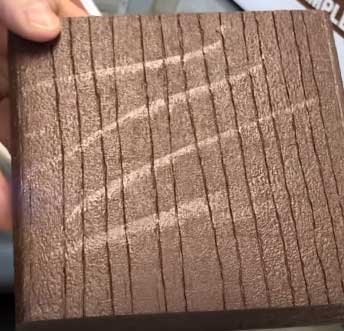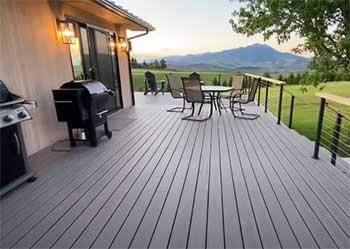If you’re in the market for new decking, you’ve probably come across two big names: Lumberock and Trex. Both are composite decking materials made from recycled plastic and wood fibers. They promise the look of real wood without all the maintenance.
But which one should you choose for your deck or patio? In this guide, we’ll compare Lumberock and Trex on the factors that matter most: appearance, durability, cost, maintenance, slip resistance, and environmental impact.
Read on to see which comes out on top for your needs.
A Brief Comparison Table
| Feature | Lumberock | Trex |
| Durability | 20+ years | 25+ years |
| Appearance | 7 color options, realistic wood grain | Wide variety of color options, highly realistic wood grain |
| Maintenance | Annual cleaning required, no staining/sealing needed | Annual cleaning required, no staining/sealing needed |
| Slip Resistance | Meets ASTM safety standards | Meets and exceeds safety standards |
| Sustainability | 95% recycled content | 95% recycled content, 2 billion+ plastic bags recycled annually |
| Warranty | 20-year residential | 25-year residential, 10-year commercial |
Key Differences Between Lumberock And Trex Decking
- Appearance

When it comes to aesthetics, both Lumberock and Trex offer options that closely mimic the look of natural wood.
Lumberock decking comes in seven colors with realistic wood grain patterns.
From warm Chestnut Brown to cool Silver Oak, you’re sure to find a hue that fits your style.
The texture is also very realistic, down to the subtle brush strokes in the grain.
Trex offers a wide variety of color choices too, from Gravel Path to Spiced Rum.
Their grain patterns are highly convincing as well. Trex claims their new Trex Enhance line is virtually indistinguishable from real wood at a glance.
Both brands score points for durability too. Lumberock and Trex resist fading, stains, mold, and mildew even after years of sun, rain, and use. You won’t have to worry about re-staining or replacing warped planks every few years like natural wood.
For aesthetics alone, it’s difficult to choose a clear winner. Lumberock and Trex are both attractive and realistic composite decking options. If one brand has a certain color or style you prefer, go with that. Otherwise it’s a matter of personal taste.
- Durability
Let’s move on to longevity. You want your new deck or patio to last for decades, not years. How do Lumberock and Trex compare?
Both composites are highly resilient against damage. Made from a mix of recycled plastic and wood fibers or sawdust, they won’t rot, crack, or splinter like 100% wood. You never have to worry about termites or carpenter ants destroying your decking either.
Lumberock claims its boards are dent resistant and 50% lighter than other composites. The lighter weight puts less strain on your structure over time. Their unique mineral-infused cap layer also helps repel scratches and scuffs.
Trex says their Transcend and Select lines are up to 54% more scratch resistant than the industry standard. The deep wood grain pattern also helps hide normal wear and tear over the years.
Trex backs their products with a 25-year residential warranty and 10-year commercial warranty.
Both Lumberock and Trex seem extremely durable and well-protected against everyday damage. Trex likely has a slight edge with their longer warranties if you want that extra peace of mind. But either option should easily last 20+ years with proper installation and care.
- Cost
Now for the tricky part – cost. Composite decking costs 2-3X more than pressure treated wood, but it saves you money in the long run through lower maintenance costs.
Lumberock costs approximately $2.50-$3.50 per linear foot. Trex decking runs $3-$4 per linear foot on average. The pricing varies by seller, quality tier, board size, and other factors. You can often find discounts buying directly from the manufacturer.
Both brands price in the middle to upper end of all composite decking materials. There are cheaper PVC and polyethylene options available (which lack the realistic wood look). There are also higher end composites like TimberTech that can run up to $7 per linear foot.
Overall, Trex tends to cost slightly more than Lumberock when comparing similar quality tiers. But both offer reasonable value pricing relative to other composites. If budget is your main concern, Lumberock gives you a bit more bang for your buck.
- Maintenance
One of the biggest composite decking advantages over wood is their minimal maintenance needs. What’s required to keep Lumberock and Trex looking pristine year after year?
With both brands, annual cleaning is recommended to remove pollen, dirt, and debris that can accumulate on the deck. You can use a regular garden hose, pressure washer, and composite-safe cleaners. Mild soap and water is usually enough for regular spills and dirt.
Beyond that, Lumberock and Trex require almost no yearly upkeep. You never need to stain, sand, or seal them. And since the color runs throughout the planks, scratches are less visible and won’t expose different shades of wood.
Perhaps the biggest maintenance advantage is avoiding splinters. Both are splinter-free, making them ideal for families with kids and pets. You don’t have to worry about getting sharp slivers in your feet when walking barefoot.
The only maintenance concern is fading color over time, though Lumberock and Trex are warrantied to resist fading. Placing your deck or patio under a covered area will further minimize sun damage.
Overall, the maintenance of both brands is as low as it gets. You’ll save hours of work and money each year compared to traditional wood decking. When it comes to easy care, Lumberock and Trex are neck and neck.
- Slip Resistance
Safety is paramount for any outdoor living space. You want decking that provides secure footing, even when wet.

Lumberock states their boards meet the rigorous ASTM slip resistance standards for safety.
The wood grain pattern gives the surface more grip versus totally smooth plastics.
Independent testing shows excellent traction when dry or wet.
Similarly, Trex says their decking provides long-lasting slip resistance that surpasses code requirements. Small ridges in the grain pattern channel water away.
You and your family can traverse Trex decks barefoot without worrying about slides or falls.
Both Lumberock and Trex seem to excel in slip resistance. Their materials and grain textures naturally create more grip and friction than wood. Caution should still be taken on dew or frost, but they are otherwise quite skid-resistant.
- Environmental Impact
Green building and sustainability are bigger concerns today. If eco-friendliness is important to you, what’s the more earth-conscious choice between Lumberock and Trex?
Being made primarily from recycled materials, both are greener alternatives to all-wood decking. Lumberock contains 95% recycled content, including reclaimed wood and plastic. The remaining 5% is non-toxic additives like mineral oil and wax.
Trex states their products use 95% recycled plastic film and wood. They keep over 2 billion plastic bags out of landfills each year. Their manufacturing process also avoids harmful chemicals and minimizes waste.
Ultimately, Lumberock and Trex are quite similar in their environmental benefits. They reuse materials, conserve trees, and avoid the toxicity issues of pressure treated lumber. Trex does make some decking with higher recycled content if sustainability is your top priority. But both are green building options for your home.
Frequently Asked Questions (FAQ)
Trex is a top brand in composite decking. Some comparable or potentially higher quality brands include: TimberTech, Fiberon, Cali Bamboo, Everdeck, ChoiceDek, MoistureShield, CertainTeed, etc.
Most major composite decking brands offer quality comparable to Trex. Lumberock performs on par with Trex across metrics like appearance, durability, cost, and maintenance. Other brands to consider are TimberTech, Fiberon, Cali Bamboo, Everdeck, ChoiceDek, and MoistureShield. The right product depends on your budget, color/style preferences, and specific performance needs.
Trex is generally considered the #1 brand in composite decking. It has the largest market share and offers some of the most realistic wood-alternative products. Other top composite brands include TimberTech, Fiberon, MoistureShield, Cali Bamboo, Everdeck, and ChoiceDek. Do your research to choose the best composite for your particular project and needs.
The lowest maintenance decks are made from composite, PVC, or polyethylene plastics. These materials avoid the cracking, rotting, splintering, and staining issues of wood decks. Brands like Trex, TimberTech, Lumberock, Fiberon, and Cali Bamboo require minimal upkeep beyond occasional cleaning. Capped composites with a protective polymer shell are ideal for a virtually no maintenance deck.
The Verdict
After this in-depth comparison, is there a clear winner between Lumberock vs Trex decking?
The truth is both make excellent composite decking brands. They are comparable across the board in appearance, durability, maintenance, safety, cost, and eco-friendliness. Personal color preference may be the deciding factor between these two.
Here are a few summary takeaways:
- Appearance – Both Lumberock and Trex look remarkably similar to real wood with no clear aesthetic advantage. Pick the color/style you like best.
- Durability – Both are extremely durable and resistant to damage with warranties of 20+ years. Trex likely has a slight edge in warranty coverage time.
- Maintenance – Negligible maintenance is required for either brand beyond occasional cleaning.
- Slip Resistance – Both meet safety standards and provide sufficient grip when wet.
- Cost – Lumberock is a little more affordable overall though prices vary.
- Sustainability – Both utilize 95% recycled content and reclaimed plastic/wood.
If you’re still unsure between the two, Trex is likely the safer choice as the industry leader. But Lumberock offers comparable quality and performance at a slightly lower cost. In the end, consult with your deck contractor and choose the best decking for your particular project needs and budget.
Whichever you select, Lumberock and Trex will provide years of enjoyment with minimal upkeep required. Turn your backyard into an outdoor oasis with composite decking that looks fantastic and stands the test of time.
